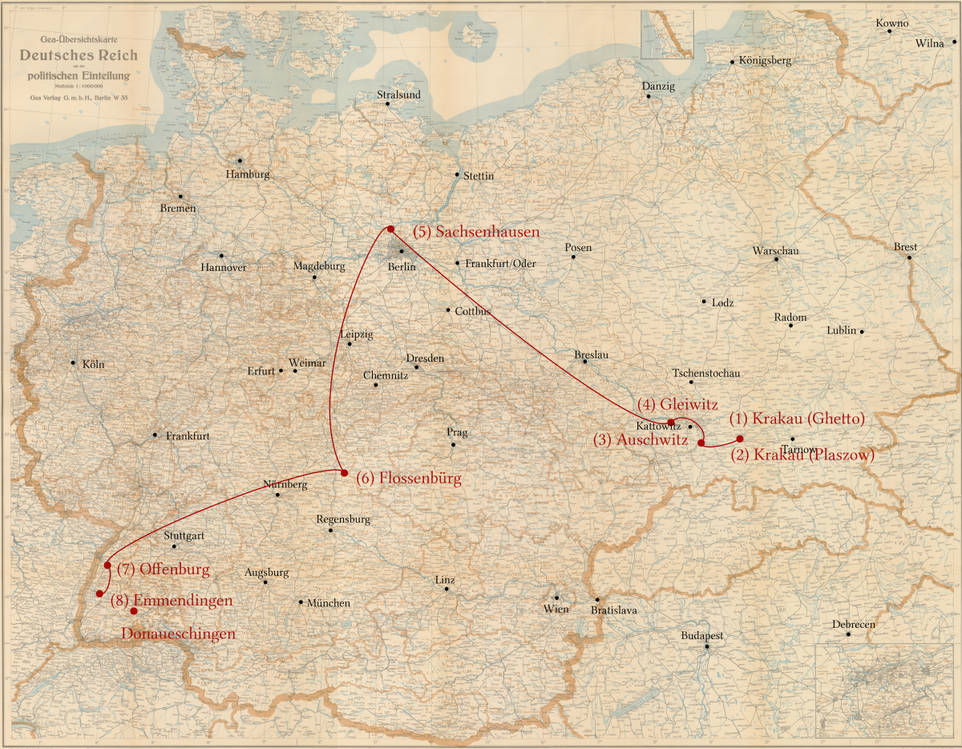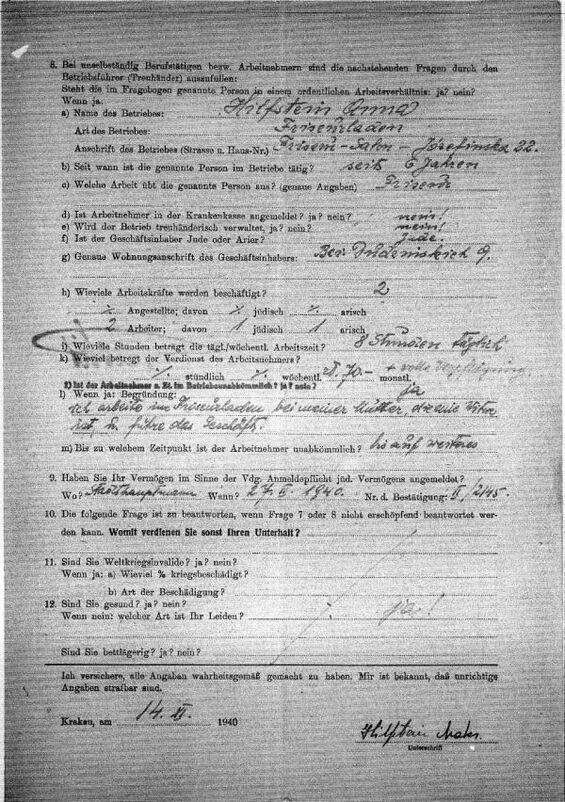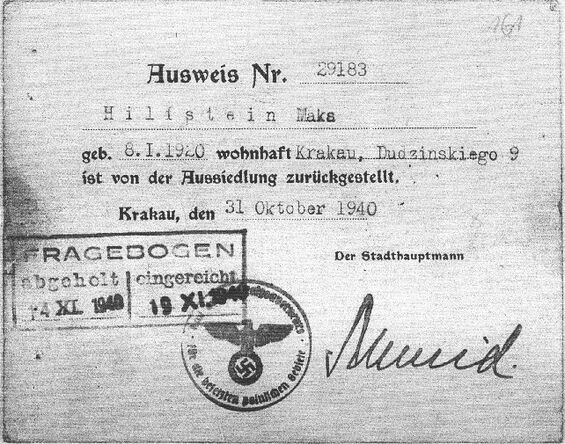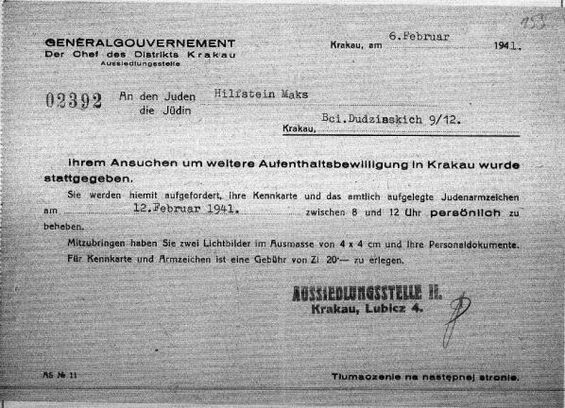The Biography of Maks Hilfstein, Krakow
Short biography and stations of his persecution
- born on 8 January 1920 in Krakow
- 1926 to 1933 primary schools
- 1933 to 1936 Vocational school for hairdressers
- October 1939 Forced labour Krakow
- 18 november 1939 Jewish star,
- 3 March 1941 Krakow ghetto
- 13.4.1943 Forced labour camp/camp Krakow-Plaszow
- January 1945 Auschwitz concentration camp
- 15 January 1945 Sachsenhausen concentration camp, prisoner number 132501
- 6 February 1945 KZ Flossenbürg, Häftlingsnummer #47451
- KZ Natzweiler-StruthofOffenburg subcamp
- 15 April 1945 liberation at Emmendíngen
- 1 January 1947 Gailingen
- 1949 emigration to USA
Max Hilfstein lost his mother in the Holocaust. He was 19 years old when his persecution began.

Before the War
I am making this affidavit in connection with my application for compensation for injury to body and health. Before the outbreak of the war I lived in Krakow at Skolna ul. 7.
I was a strong, healthy boy and I had no physical complaints. After finishing primary schools, I was trained as a hairdresser. My father died in 1934 and I took over his business, even though I was only 16 years old. The shop was called Leon Hilfstein and was located in Krakow at Jasofinska ul. 22. I had a good income and endeavoured to expand my hairdressing business.
Source: Unless otherwise stated: Konrad Kittl files, Max Hilfstein affidavit;
Forced Labour and Ghetto
When Krakow was occupied, I was immediately persecuted like everyone else. I was forced to do dirty cleaning work, especially shovelling snow. I was still able to work as a hairdresser, but I was often harassed. When a typhus epidemic broke out in the early years, I was ordered to the hospital as a hairdresser. I contracted paratyphoid here.
When the ghetto was set up, I had to move in. The conditions here were very filthy. Just before the ghetto was liquidated, I lost my whole family, i.e. they were taken away and my mother was probably shot on Gordo Square. I was called in for the liquidation, i.e. the cleaning. We had to recover the bodies and collect the property left behind for the Nazis.
Note: Apart from "useful" Jews, the Jewish population was to leave Krakow. In order to be allowed to stay, Jews had to submit an application to obtain the right to stay and a corresponding identity card.
Source: Krakow ghetto, retrieved on 3 October 2019.
As early as the occupation of Krakow in 1939, client was no longer able to work regularly in the shop because he had to do forced labour for the Germans in the form of cleaning streets and flats. When Germans entered the shop, he had to serve them as a hairdresser and was beaten over the head as payment (at the moment he reports this, he gets a severe stomach cramp and squirms in his chair)
In the Krakow ghetto, a Jewish school was set up as a hospital; client was employed there as a hairdresser and nurse. He contracted paratyphoid fever and was unable to work for a week.
There were many shootings in the Krakow ghetto; 6 people were shot in his flat alone. client had to load the dead, sort the clothes of those who had been shot, and also came across his brother's. Client was punished once with 25 lashes and then a second time. Many Jews were deported from the Krakow ghetto and the ghetto was reduced in size. On 13 March 1943, client's mother was deported to Treblinka and perished there. client was already informed about the significance of Treblinka by an escapee.
He then married a tailor in the ghetto. He once had to watch her being severely beaten by an SS man and still suffers from the humiliation today. He also suffers from the fact that he was always called Hilfsschwein.
Expert report by Herman O. Pineas, 25 June 1969, New York
Documents from the Krakow ghetto
Plaszow Forced Labour camp
Then I came to Plaszow. I was first sent to the furrier's barracks and then I had to work in the armoury. I was constantly harassed. I was emaciated and often suffered from chills. It wasn't enough that we had to work 12 hours, we were often chased out at night and had to carry stones.
| Concentration camp Kraukau-Płaszów | |
|---|---|
| Location | Kraków-Płaszów / Kraków-Plaszow |
| Name | |
| Area | General Government, Krakow District (1939-1944) |
| Opening | 11.01.1944, previously a forced labour camp for Jews |
| Closing | The prisoners were "evacuated" to Auschwitz on 14 January 1944. They arrived at Auschwitz II (Birkenau) concentration camp on 17 January 1945. The camp was occupied by the Red Army on 15 January 1945.</td |
| Deportations | In March 1944, around 2,000 prisoners were transferred to ZAL Skarzysko-Kamienna. In April 1944, 1,100 Jews arrived from ZAL Drohobycz. On 14 May 1944, 1,400 "unfit for work" prisoners were taken to Auschwitz to be murdered. At the beginning of August 1944, 6-8,000 prisoners were deported to Auschwitz, around 5,000 to Mauthausen, around 4,600 to Flossenbürg and around 4-5,000 Hungarian Jewish women to Stutthof via Auschwitz. On 15 October 1944, 1,500 prisoners were transferred to Groß-Rosen and some to Buchenwald.</td |
| Prisons | A total of around 25,000 - 30,000 prisoners were sent to the camp, half of whom were Polish. In September 1944, the number of prisoners was around 2,200, at the beginning of 1945 it was 636.</td |
| Gender | Men |
| Comments | A total of around 8,000 prisoners died in Krakow Plaszow. The Krakow Gestapo carried out mass shootings in the surrounding area. Around 3,000 to 4,000 Jews and other prisoners were killed there.</td |
| Source: germany-a-monument | |
The last months
In January 1945, as the Russians approached our territory, we were driven on the so-called death march. We had to walk to Auschwitz. Many died in the process. We only stayed here for one or two days. I still remember the terrible minutes when we were sent into a chamber to take a shower. We all thought we were going to be gassed.
Note: The prisoners were "evacuated" to Auschwitz on 14 January 1944. They arrived at Auschwitz II concentration camp (Birkenau) on 17 January 1945. The camp was occupied by the Red Army on 15 January 1945."
Source: deutschland-ein-denkmal.de, Concentration camp Krakow-Plaszow, retrieved on 3 October 2019 }.
As the Russians were not far away, we were dragged to Gleiwitz-Sachsenhausen and Flossenbuerg. Some of us were transported in cattle wagons. There were 100 to 150 prisoners in one wagon. More than half of them died during the journey. We were travelling for a long time and we didn't get any food. I don't remember how I survived. I had to work again in Flossenbuerg. One day, when a supervisor wasn't happy with my work, I was brutally beaten up. I couldn't move later because of the pain. But I didn't care at that point, as it was only a matter of time before I died. I was sent to Offenburg, where I was later liberated.
Offenburg
| Subcamps of the Natzweiler-Struthof concentration camp | |
|---|---|
| Location | Offenburg |
| Area | Baden |
| Prisons | In March 1945: 635 prisoners, including Poles, Belgians, Italians and citizens of the USSR and Czechoslovakia |
| Type of work | Defence and clean-up work |
| Comments | A transport of 635 prisoners from Flossenbürg concentration camp arrived in Offenburg at the end of March. They were housed in the Ihlenfeld barracks. On 6 April 1945, the commandant's office of the Natzweiler concentration camp transferred a further 33 prisoners. The deaths of 23 prisoners were registered. [We do not know which institution the prisoners were assigned to. Due to the transfer of the Natzweiler concentration camp, the command is listed here. |
| Source: germany-a-monument | |
After the War
After my liberation I stayed in West Germany until my emigration to the U.S.A. in 1949. I received constant medical help from UNRRA doctors and still remember the name Schmidt in Constance and Dr Walter Gailingen.
Notes
Further Sources
Office for Compensation
Stuttgart AZ ES 21255, 21855/Karlsruhe EF3688, 1964-1971
Notes
---
Picture Credits
- RG-15.098M; Coll: City captain of the city of Krakow, 1939-1945, ID card list; Name List: Accepted Applications; United States Holocaust Memorial Museum Archives, Washington, DC.
- RG-15.098M; Coll: City captain of the city of Krakow, 1939-1945, ID card list; Name List: Accepted Applications; United States Holocaust Memorial Museum Archives, Washington, DC.
- RG-15.098M; Coll: City captain of the city of Krakow, 1939-1945, ID card list; Name List: Accepted Applications; United States Holocaust Memorial Museum Archives, Washington, DC.
- RG-15.098M; Coll: City captain of the city of Krakow, 1939-1945, ID card list; Name List: Accepted Applications; United States Holocaust Memorial Museum Archives, Washington, DC.
- 1.1.8/10886910/ITS Digital Archive, Arolsen Archives

![Fragebogen zur Erfassung der jüdischen Bevölkerung - 1; Quelle: USHMM Fragebogen zur Erfassung der jüdischen Bevölkerung - 1; Quelle: [1]](/assets/images/0/HilfsteinErgBog_1-exqfqd3prs4dyjv.jpg)



